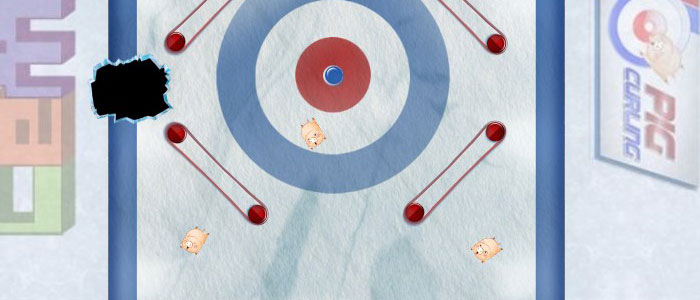[tab:Review]
A hit like Angry Birds is bound to spawn numerous clones with minor tweaks. Pig Curling changes things up in some really exciting ways that make it rise above a simple also-ran. Sadly, the game takes that marvelous setup and largely blows it with poor level design and uneven execution.
The basic idea behind CEMG Apps’ Pig Curling is simple–use a finger to flick pigs onto a target. The game walks the player through the increasing complications, including pigs with different sizes, weights and special abilities, surfaces with differing amounts of friction and obstacles with various properties. Each level has a number of pigs the player must land within the target (generously determined) in order to unlock the following level. In addition, landing pigs in rings closer to the bullseye yields more points, which elevates one’s status on the Game Center-integrated leaderboard.


Flicking as a control mechanism offers a longer learning curve, with more opportunity to employ dexterity and develop skill than Angry Birds’ catapult. Just as with the birds, the only other way to interact with pigs once they’re on their way is a single tap to activate the special ability of those that have one. The four worlds (each with a different surface) offer a reasonable number of puzzles, but the ability to hone one’s skill and increase scores on each level extend the potential life of the game quite a bit. Combined with the intent to release new worlds in the future, Pig Curling could provide excellent value to a dedicated player.
An important strategic consideration enabled by the switch from pure destruction to placing pigs on a target is the interaction between pigs already on the board and the active pig. Even with the simplest pigs, there’s a delicate balance between trying to gain as high a score as possible and leaving the pigs already in scoring position where they are. Several of the pigs’ special abilities are designed to complicate this calculus, and the idea of a pig which one uses to make later pigs easier to control offers some fascinating strategic options.
Sadly, the level design fails to capitalize. Rather than slowly introducing elements and challenges so that the player develops an awareness of the subtle concepts that emerge from the nature of the game, Pig Curling essentially tells the player what each element is for, and then turns it into an assignment. Worse, the joy of discovery of a good solution is often hampered by design choices, which make the implementation of that solution dependent on something over which even superhuman dexterity would give one no control. A good example is the series of walls in level 2-5: the holes in the walls are too small to effectively aim for, so they don’t afford a distinct strategy. However, they mean that pigs which would bounce off solid walls as the player intended sometimes bounce off in wildly different directions. It gives the game a random feel, which undermines its role as a puzzler.
Uninspiring level design would seem like a mere missed opportunity, but the frustration caused by it is dramatically exacerbated by some glaring errors in collision detection. The most egregious of these occurs on the “three little pigs”. These are visually represented by a triangular arrangement until they split up, but will collide with any obstacle in a radius at least as large as its outermost point. This extends its hitbox well beyond the visible sprite, and makes levels in which precise control is needed to thread a needle infuriating.


This sort of sloppiness crops up in numerous areas of the game. Two unexpected quits and two levels with no pigs to flick marred my play experience. The achievements are disturbingly shoddy, with several earned but unawarded, several which require pigs or worlds with which the game does not ship and two separate achievements for completing the first level (neither of which actually triggered). None of these is remotely game-breaking, but they’re certainly disappointing. They add to the general impression of a hasty release, which one might well develop as soon as the main menu loads, if one notices that there is exactly one lower-case letter.
Graphically, this is a fairly simple game, but the Blades of Steel aesthetic comes through nicely, and the pigs have a generic cuteness, which may help attract casual gamers. The audio is similarly twee–not actually objectionable, but I preferred to turn it off.
Pig Curling is in many ways exactly what I want out of a game: it’s similar enough to a popular touchstone to be easy to think about, while introducing enough innovation to demonstrate that there’s a very large design space to be explored. It gives one the boost needed to ask what one could do with scoring zones not shaped like archery targets, perhaps even multiple targets, or pigs one uses not to score, but to add various kinds of board elements or accomplish other tasks (perhaps exploring a partially-obscured level). But the execution is sufficiently flawed that I would only recommend the game to someone interested in exploring what Angry Birds could have done. Happily, most of what frustrates me about the game could be improved in a later update, and the apparent commitment to continued development offers hope that it may soon fulfill its promise.
Review copy provided by publisher.
[tab:Screenshots]
[tab:END]
